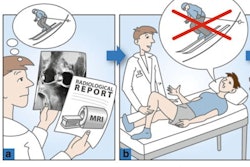
"Spoken words fly away, written words remain," according to the Latin proverb. But how can you improve the quality, clarity, and impact of your letters to patients, referring doctors, and colleagues? The U.K. Royal College of Radiologists (RCR) has issued a new document that offers 10 tips, which are summarized below.
1. Be clear on why you are writing the letter
Letters are written to convey information to many different people. They may form a record for the treating team, provide information for the general practitioner (GP) or referring team, or provide a summary for the patient.
"A letter cannot be all things to all people and is not just a record of a consultation," the authors noted. Before writing the letter, they advised thinking about to whom the letter is being sent and for what reason.
2. Write letters directly to the patient whenever possible
Direct patient communication is recommended by the Academy of Medical Royal Colleges in the U.K. Minimize the use of specialist jargon and abbreviations, and explain technical points to ensure the correspondence is truly patient-centered and to make the letter easier to understand for everyone, the authors advised.
3. Use headings throughout the letter
Headings give structure to signpost the reader to the information that is most important. Also, headings stating a plan or an instruction for the reader should be highlighted at the top of the letter and possibly in bold, they added.
The U.K. Professional Records and Standards Body (PRSB) has developed a list of mandatory and recommended headings for outpatient letters, following patient and clinical consultation. The RCR has assisted the PRSB in developing letter templates for use in clinical oncology, using the recommended headings.
4. Keep the letter brief, clear, readable, and relevant
Long passages of text tend not to be read, so stick to short sentences and try to make paragraphs about one topic only.

5. Make sure that information is up to date, accurate, and unambiguous
Diagnosis summaries and current situation headings are often very helpful but only if they are revised following a consultation. They should not be copied directly from a previous letter.
6. The treatment summary: a tool for the patient and handover of care
A treatment summary is an extremely important tool to explain to the patient and other healthcare professionals what treatment has been given and why. It also makes clear the common side effects of the treatment and potential symptoms of recurrence of disease.
The treatment summary should give clear instructions on what to do if symptoms persist or side effects occur, and it facilitates the handover between secondary and primary care, according to the authors.
In the U.K., Macmillan Cancer Support has developed templates for writing treatment summaries.
7. Give an opinion and spell out next steps
"The patient has come to clinic for an opinion, and it is important to give this in the letter and not simply repeat facts that are available elsewhere," the authors wrote. "The treatment plan for the future should be clearly set out. Most importantly, if the intention of treatment has changed, this should be made clear in the follow-up letter."
For instance, modern oncology treatments have improved so that a palliative treatment may still mean an expected prognosis measured in years rather than months, and this can help colleagues understand possible time frames that can be invaluable in planning care.
Where actions are required, list these clearly with time frames and identify who is responsible for each one, they recommended.
8. Ensure contact details are correct
Give the most appropriate contact information, so the readers can follow up easily if they have questions.
9. Develop your dictation skills
"Make transcription of your letters easy -- dictation is a skill," the authors stated. Make sure you speak as clearly as possible, confirm the patient's name and the consultation date, and, if possible, work with your secretary on useful, predefined templates and the format and style of your letters.
10. Get feedback
Don't get stuck in a rut: Ask for feedback from staff and patients, and make sure you read colleagues' letters and try to improve the quality of yours over time, they advised. The Sheffield Assessment Instrument for Letters (SAIL) audit tool can be used as a part of personal or departmental audit of letter quality.
The RCR's Clinical Oncology Professional Support and Standards Board approved these 10 tips on 17 May 2019. You can download the original document on the RCR website.



















